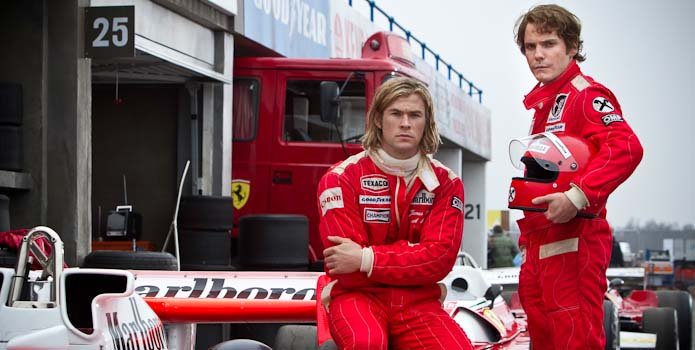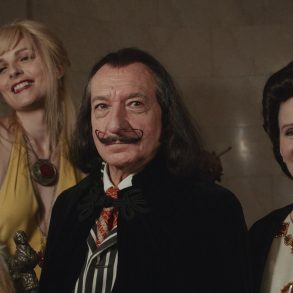Director: Ron Howard
Writer: Peter Morgan
Stars: Daniel Brühl, Chris Hemsworth, Olivia Wilde
Runtime: 123 min
Rating: 14A
It requires a talented director to take a subject that may not interest all and create a film with wide appeal. Fortunately, legendary director Ron Howard is more than up to this challenge. His new film, Rush, depicts the world of Formula One race car driving in a manner that is sure to intrigue more than just fans of the sport. Focusing on complex characters instead of relying on fast cars and hot chicks to generate interest, Howard crafts a fascinating piece with a real story at the heart of all the spectacle and excitement.
Rush is based on the real-life racing rivalry between the risk-taking playboy James Hunt (Chris Hemsworth) and the brainy, straight-laced Austrian Niki Lauda (Daniel Brühl) that took place during the 1970s. While James spends his free time abusing substances and bedding beautiful women, Niki dedicates every spare moment to perfecting his car and his skills. Both men are seriously tested, both in their personal lives and out on the track, where their lives are in constant danger. The competition may appear to be a typical case of brawn versus brains; however, one realizes by its conclusion that this film is far from a typical sports movie. When the question of just how far these rivals will go in order to beat the other and secure the title of world champion is addressed, the answer will certainly surprise.

Instead of allowing this film to become a spectacle piece, director Howard places his focus squarely on the captivating characters found within. A double narration technique allows the audience into the minds of both principle characters; we see the backstories and perspectives of both, and are able to compare and contrast appropriately. We therefore understand many of their actions and motivations, and are able to judge for ourselves for whom we should root. As James, Hemsworth is admittedly a bit over-the-top and eager, but so is this character that an audience can’t help but like. Brühl’s Nicki is a more relatable figure, not only because of the hardworking personality of his character, but also due to Brühl’s nuanced acting abilities. It is the fascination in these two magnetic characters that generates an interest in the film for a non-racing fan such as myself.
The intense filming techniques used within this movie work to effectively draw a viewer right into the fast-paced action. During the breathtaking race sequences, the camera jumps from showing the perspective of the drivers to that of the spectating crowds, allowing the audience several points of view through which to view the events. Pounding sound and relentlessly realistic motion place a viewer right into the race stadium, generating interaction and suspense. Blessedly, the film is not weighed down with unnecessary races, so that when they do occur they all manage to produce excitement and create a thrill.

Amidst the danger and glamour of Formula One racing, Ron Howard has discovered something that is necessary for a successful film: a captivating story that has the potential to generate a real emotional response. The moral here is not that of a typical sports movie, and the result is a valuable and refreshing new take on the genre. After the film takes a dark turn, both the public in the movie and the audience watching from the theatre are able to get behind a heroic figure. Howard is able to tap into emotion in a way that few directors can, and one may be surprised to realize how much they actually care about the outcome. It is Howard’s ability to get right inside the minds of his characters, sometimes literally as they provide narration, that generates the intrigue into this film. This piece is a work that is sure to engage even those for whom fast cars hold no appeal, since it is at its heart a movie about people, not machines.
Photo Credits: Toronto International Film Festival







